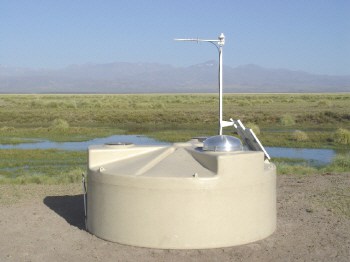The Pierre Auger Observatory became the biggest cosmic-ray detector in the world this week with the completion of its hundredth detector. The observatory, which will eventually contain more than 1600 detectors, is still being constructed on a vast plain known as Pampa Amarilla in western Argentina. The project is a collaboration between 14 countries, including Argentina, Brazil, the US and several European nations, and the total cost is $55m.

Cosmic rays are particles from outer space that continually bombard the Earth. A cascade of particles known as an “air shower” is created when the cosmic rays interact with particles in the Earth’s atmosphere, and it is this air shower – which can grow to several kilometres across by the time it reaches the Earth – that is detected in cosmic-ray experiments.
Physicists believe that cosmic rays with low-to-medium energies come from supernovae explosions. However, a small number of ultrahigh-energy cosmic rays – particles with energies above 1020 electron volts (eV) – have been detected by the AGSA experiment in Japan and the Hi-Res experiment in the US. However, the results from these two experiments – which use completely different detection methods– do not agree with each other. Moreover, theory predicts that the rays should have a maximum energy of about 5×1019 eV.
The AGASA experiment relies on measuring the Cerenkov radiation that is generated when particles in the air shower pass through large tanks of pure water. Hi-Res, meanwhile, detects the fluorescence that is produced when the air shower interacts with nitrogen in the Earth’s atmosphere. The Auger observatory will be much bigger than either of these experiments and will employ both detection techniques in an attempt to find out how and where ultrahigh-energy cosmic rays are accelerated to such high energies.
When the observatory is completed in 2005 it will contain 1600 water detectors and 24 fluorescence telescopes. Each detector will be separated by about 1.5 km and the entire array will occupy an area 3000 square kilometres, making it the largest experiment ever built. Ultrahigh-energy cosmic rays strike the Earth once per century per square kilometre, so Auger should record about 30 of these events per year, along with large numbers of lower-energy cosmic-rays. The Auger collaboration is also preparing a proposal to build a second detector of the same design in the US.




